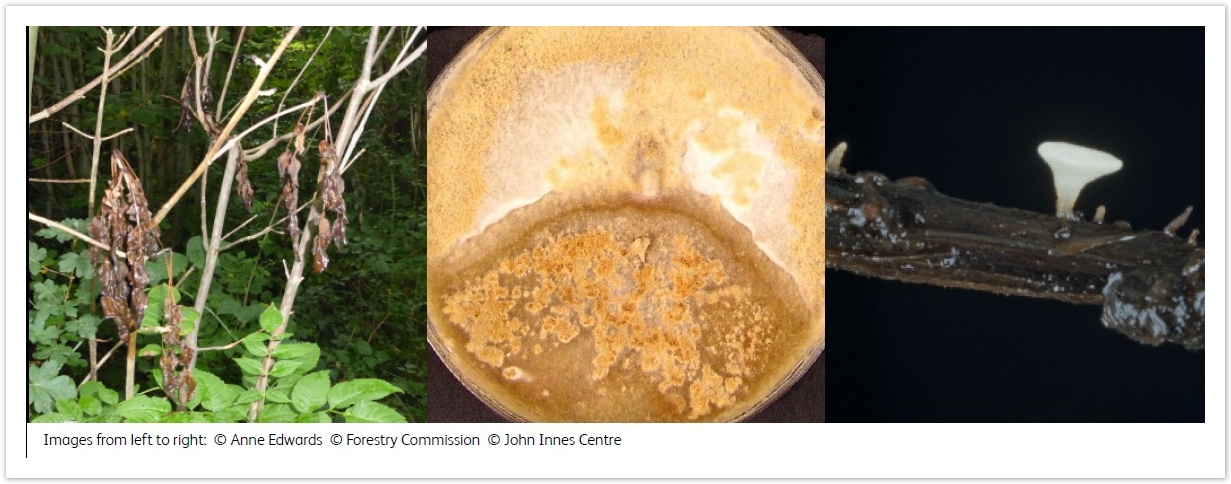

Ash dieback (ADB), a devastating disease responsible for destroying vast numbers of ash trees in continental Europe and Scandinavia, is on the move. Caused by the fungus Hymenoscyphus pseudoalbidus, the disease was first identified in the UK in 2012 and has since been found at hundreds of sites throughout Britain and Ireland. It is likely that resistance to ash dieback will evolve in the UK ash population over time through natural selection. This poses an important challenge for forest scientists: to accelerate this process so that the UK’s ash population can recover much more rapidly.
This project will investigate the ecological genetics of H. pseudoalbidus and its ability to evolve in response to natural selection. The researchers will look at the vegetative compatibility (VC) of the fungus, the system which allows fungi to distinguish between self and non-self, which could be manipulated to lessen the ash dieback epidemic. Variation in genetic diversity and pathogenicity of H. pseudoalbidus between populations and within trees will be explored, providing insights into the operation of natural selection on the fungus within its host. In addition, the study will look at the relationship between H. pseudoalbidus and the harmless H. albidus, a closely related fungus which is also found in the UK. By gaining vital information about the ash dieback fungus, the researchers hope to promote breeding and management of natural and commercial ash populations to control this aggressive disease.
This project is in partnership with Forest Research, Alice Holt Research Station (project participants).
Project webpage http://www.forestry.gov.uk/fr/infd-9kchzr
Specific objectives (edited for this web site):
1. Vegetative incompatibility in Hymenoscyphus pseudoalbidus (Hp). Ascomycetes have a system of self/non-self recognition known as vegetative compatibility (VC). When hyphae of genets in different VC groups (VCG) encounter each other they form mycelial barrages, often associated with apoptosis. VC is important in fungal population biology because it delineates the territory occupied by a genet, giving it sole access to the resources therein and can be highly relevant to disease control. We will investigate the spatial structure of VCG in the UK population of Hp, comparing older and more recent outbreaks.
2. Genetic variation in local populations of H. pseudoalbidus. Current evidence suggests that Hp is an ecologically near-obligate pathogen. The appearance of ascocarps on dead plant tissue in leaf litter may represent a dormant phase rather than saprotrophic growth. The active population dynamics of the fungus, including natural selection, probably takes place within the host plant. Using VCG and DNA markers, we will; a) estimate genetic diversity in Hp and the differentiation between and within local populations; b) test whether or not the two mating types of Hp have approximately equal frequencies in the UK; c) investigate variation within trees, particularly the size of the domains established by individual fungal genets. Population genetic analysis will provide insights into the mode of dispersal, which established Hp in the UK and suggest ways of managing ash to minimise further dispersal of this fungus.
3. Variation in traits related to fitness in H. pseudoalbidus. An important general feature of host-parasite coevolution is that a cost of increased pathogenicity in terms of pathogen fitness can increase the long-term frequency of resistance in the host. We will investigate fitness costs in Hp by testing if there are correlations between important pathogenicity and life-cycle traits. Knowledge of possible costs of pathogenicity may help to guide strategies for breeding commercial ash trees for resistance to Chalara ash dieback and encouraging the flow of resistance genes in the host population.
4. Comparative variation in Hymenoscyphus albidus. Hymenoscyphus albidus (Ha) has been known on ash in the UK since the 19th century but is not regarded as a pathogen. Hymenoscyphus albidus and H. pseudoalbidus are distinct but sufficiently closely related that they might interact by exchanging genes or parasites. We will investigate the ecological and genetic relationship between Hp and Ha to discover what potential there is for deleterious dsRNA species to be transferred between the two Hymenoscyphus species that would contribute to long-term inhibition of H. pseudoalbidus and thus to control of Chalara ash dieback.
|